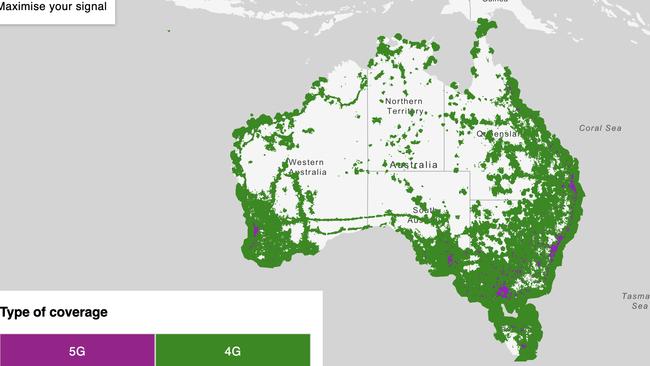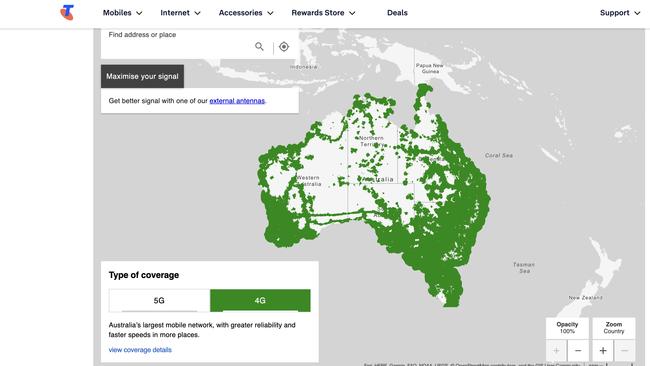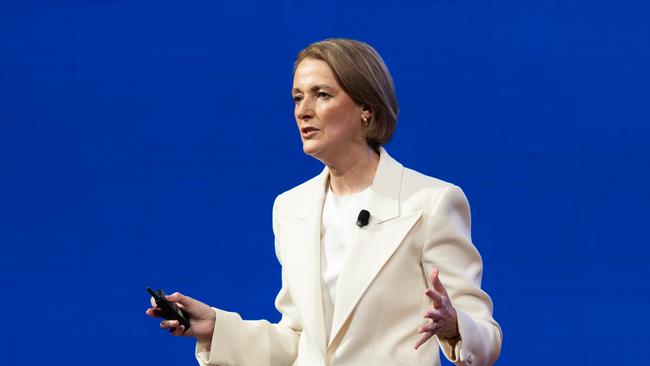Telstra says coverage maps ‘not perfect’ amid claims it duped Australians
The telco says its maps are ‘not designed to perfectly visualise’ as it attempts to brush off allegations it overstated the size of its network, ‘tricking’ Australians.

Business
Don't miss out on the headlines from Business. Followed categories will be added to My News.
Telstra says its coverage maps are “not designed to perfectly visualise” its three million square kilometre claim as it attempts to brush off allegations it overstated the size of its network, “tricking” Australians.
Fresh analysis of Telstra’s coverage from Vodafone owner TPG Telecom also reveals about 800,000 square kilometres of Telstra’s coverage is over the ocean and does not require an external antenna. This would lift Telstra’s coverage to almost three million square kilometres, based on publicly available data it has supplied to the competition watchdog.
But, a Telstra spokesman said its coverage claims referred to landmass only — not over the ocean — puzzling TPG engineers about how the nation’s biggest telco calculates its coverage.
“It’s very difficult for anyone to understand where Telstra’s claimed three million square kilometres of coverage is, or if it exists at all,” a TPG spokesman said.
Independent drive tests from Accenture — which is performing a $20m, three-year audit of mobile coverage on behalf of the federal government which is set to be completed in 2027 — have also found so far that Telstra customers cannot access three million square kilometres of coverage without an external antenna.
Telstra has two coverage maps on its website, a standard version — which aligns with Accenture’s tests — and one that asks people if they want to “maximise their signal” with an antenna.
When asked to clarify which map referred to the three million square kilometres of coverage, a spokesman did not directly answer the question.
Instead, the spokesman referred to a raft of caveats that can affect coverage, saying its maps were not “perfect”.
“There are a range of factors that impact on mobile coverage like the specific handset you use, how you use it (e.g. in a car, outdoors, indoors or even how you hold it), surrounding terrain and the generation of mobile network you’re connecting to (e.g. 4G or 5G),” the spokesman said.
“Our maps are therefore not designed to perfectly visualise our three million square kilometres of coverage claim.”

Vodafone owner TPG accused Telstra of overstating its network by about one million square kilometres last month, attracting the attention of the consumer watchdog, which is examining the allegations.
Since then Telstra has become the first major telco to launch satellite direct-to-handset text messages.
After TPG contacted Telstra with its concerns, Telstra initially said its three million square kilometres of coverage was based on using an external antenna — not what people could expect to use from a regular mobile phone.
But, five days after this masthead revealed the allegations, Telstra said it had performed “rigorous” retesting. Chief executive Vicki Brady said these tests showed its three million coverage claim was “right all along” and “it doesn’t require an antenna”.
But, Ms Brady acknowledged there were black spots within the three million square kilometre footprint where calls dropped out or could not be made.

Telstra has declined to reveal the quantity of these “known black spots”. It also has refused to say what the minimum decibels per watt (dBm) level is that it sets during testing to measure the strength of a mobile signal.
TPG analysed coverage maps Telstra provided to the ACCC last year and found its “outdoor” network — or what people could expect to use just with a mobile phone and not an antenna — was 1.9 million square kilometres. This is about one million less than Telstra had claimed.
Telstra typically increases the size of its network by about 100,000 to 200,000 square kilometres a year. If it did the same in the past 12 months, this would bring its outdoor network to 2.1 million square kilometres.
Further TPG analysis found that Telstra provided about an extra 800,000 square kilometres of outdoor coverage over the ocean which didn’t require an antenna and would bring Telstra’s coverage claim to around three million square kilometres. Optus and TPG don’t count ocean coverage in their network claims, nor do Telstra’s wholesale customers, which include Woolworths, Aldi and others.
A Telstra spokesman said it also did not include ocean coverage, saying it was a bonus.
“Our three million square kilometres of coverage claim is based on Australian landmass only,” he said.
“We know that many of our customers also benefit from our coverage on the water, but we don’t include this in our three million square kilometres coverage claim.”
Aldi has removed Telstra’s coverage claims from its website since TPG aired its allegations.
Telstra has said repeatedly it is difficult for any telco to accurately measure the size of its network, but it maintains its offers Australia’s largest by a considerable margin.
“On any measure, Telstra’s network is at least one million square kilometres larger than Vodafone’s — that’s an area more than 14 times the size of Tasmania,” a spokesman said last month.
“No mobile network operator can test every square metre of Australia’s landmass in person and there are a range of factors that impact on mobile coverage. Like all mobile networks, there will be some locations inside the coverage footprint where calls either drop or can’t be made, due to physics and terrain.”
Still, the Australian Shareholders Association has called for independent verification of coverage claims, while Nationals Senator Bridget McKenzie says if Telstra continues to be “ambiguous” it will face the “full glare” of a potential senate inquiry.
Former ACCC chair Allan Fels — who has previously argued for Telstra to be broken up — said the size of Telstra’s network has been a “considerable marketing attribute” that has attracted “more customers away from competitors”.
“Many people who travel around Australia purchase Telstra products because of their belief that they’ve got unsurpassed coverage,” Professor Fels said last month.
More Coverage
Originally published as Telstra says coverage maps ‘not perfect’ amid claims it duped Australians





